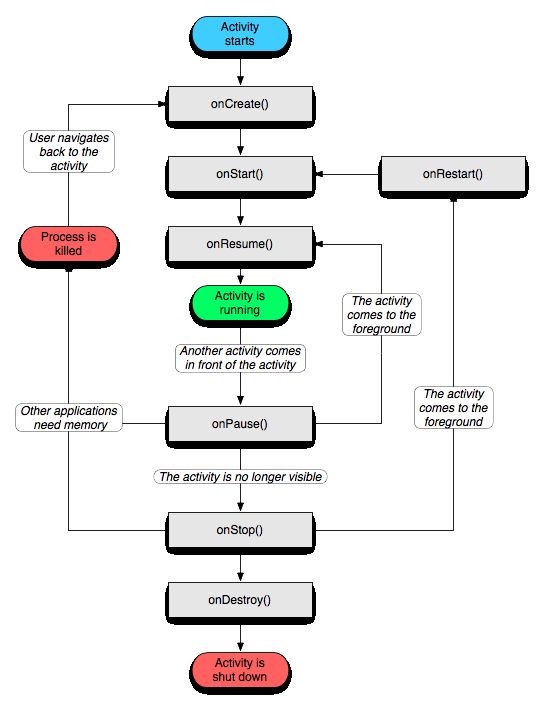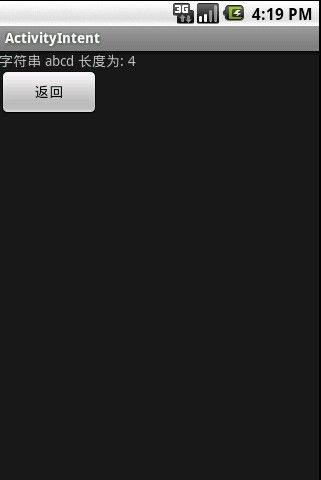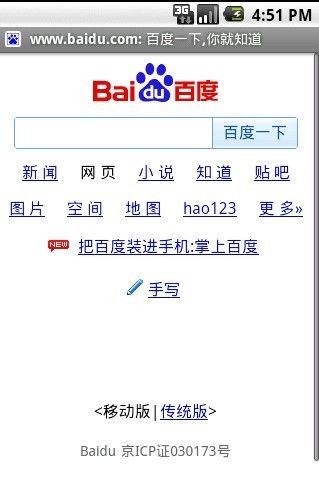Android之Activity的生命周期和Activity间的跳转和数据传递
Activity,是Android中一个重要的组件。就像任务管理进程,每个Activity负责一个任务,一般都是一个页面对应一个Activity,Activity负责响应当前页面的所有请求和处理。而Activity的生命周期,也和进程很类似,它有创建(OnCreate)、开始(onStart)、暂停(onPause)、唤醒(onResume)、停止(onStop)、重启(onRestart)、销毁(onDestroy)等状态。下面一幅图,清楚地描述了这些状态的转变:
Activity启动的流程包括:onCreate()->onStart()->onResume()
Activity关闭的流程包括:onPause()->onStop()->onDestroy()。
Activity重启的流程包括:onPause()->onResume()或者onStop()->onRestart()
下面再通过实例来讲述Activity的生命周期:
(1)启动Activity1
(2)从Activity1中启动Activity2(注意Activity1这里并没有调用finish()方法)
(3)从Activity2中返回Activity1(注意Activity2这里调用了finish()方法,会引发onDestroy()方法)
(4)退出Activity1,程序结束
可以看出Activity1经历的生命周期为:onCreate()->onStart()->onResume()->onPause()->onStop()->onRestart()->onResume()->onPause()->onStop()->onDestroy()
Activity2经历的生命周期为:onCreate()->onStart()->onResume()->onPause()->onStop()->onDestroy()
实例视图与具体代码如下:
1、布局文件
Activity1的布局文件main.xml:
<?xml version="1.0" encoding="utf-8"?> <LinearLayout xmlns:android="http://schemas.android.com/apk/res/android" android:orientation="vertical" android:layout_width="fill_parent" android:layout_height="fill_parent" > <LinearLayout android:orientation="horizontal" android:layout_width="fill_parent" android:layout_height="wrap_content" > <TextView android:id="@+id/textView01" android:layout_width="wrap_content" android:layout_height="wrap_content" android:text="输入字符串:"/> <EditText android:id="@+id/et_string" android:layout_width="203px" android:layout_height="47px" android:textSize="18sp"/> </LinearLayout> <Button android:id="@+id/bt_toActivity2" android:layout_width="fill_parent" android:layout_height="wrap_content" android:text="计算字符串长度"/> <LinearLayout android:orientation="horizontal" android:layout_width="fill_parent" android:layout_height="wrap_content" > <TextView android:id="@+id/textView02" android:layout_width="wrap_content" android:layout_height="wrap_content" android:text="字符串长度为: "/> <TextView android:id="@+id/tv_result" android:layout_width="202px" android:layout_height="wrap_content" android:textSize="18sp"/> </LinearLayout> <Button android:id="@+id/bt_url" android:layout_width="fill_parent" android:layout_height="wrap_content" android:text="打开百度网站"/> </LinearLayout>
Activity2的布局文件 mylayout.xml:
<?xml version="1.0" encoding="utf-8"?> <LinearLayout xmlns:android="http://schemas.android.com/apk/res/android" android:orientation="vertical" android:layout_width="fill_parent" android:layout_height="fill_parent" > <!-- 显示结果 --> <TextView android:id="@+id/tv_showResult" android:layout_width="fill_parent" android:layout_height="wrap_content" android:text="" /> <!-- 返回另一个Activity --> <Button android:id="@+id/bt_back" android:layout_width="100px" android:layout_height="wrap_content" android:text="返回" /> </LinearLayout>
2、代码
Activity1的程序代码
package com.myandroid.test; import android.app.Activity; import android.content.Intent; import android.content.SharedPreferences; import android.net.Uri; import android.os.Bundle; import android.util.Log; import android.view.View; import android.view.View.OnClickListener; import android.widget.Button; import android.widget.EditText; import android.widget.TextView; public class ActivityIntent extends Activity { private Button bt_toActivity; private Button bt_outsideIntent; private EditText et_string; private TextView tv_result; /** Called when the activity is first created. */ @Override public void onCreate(Bundle savedInstanceState) { super.onCreate(savedInstanceState); setContentView(R.layout.main); Log.e("Lifecycle_Activity1", "onCreate()"); et_string = (EditText) findViewById(R.id.et_string); bt_toActivity = (Button) findViewById(R.id.bt_toActivity2); bt_outsideIntent = (Button) findViewById(R.id.bt_url); tv_result = (TextView) findViewById(R.id.tv_result); bt_toActivity.setOnClickListener(new ClickEvent()); bt_outsideIntent.setOnClickListener(new ClickEvent()); } //销毁:onPause()->onStop()->onDestroy() @Override protected void onDestroy() { super.onDestroy(); Log.e("Lifecycle_Activity1", "onDestroy()"); } //暂停:onStart()->onPause() @Override protected void onPause() { super.onPause(); Log.e("Lifecycle_Activity1", "onPause()"); //把数据保存到类似于Session之类的存储集合里面 SharedPreferences.Editor saveData = getPreferences(0).edit(); saveData.putString("value", et_string.getText().toString()); saveData.commit(); } //重启:onPause()->onResume() @Override protected void onResume() { super.onResume(); Log.e("Lifecycle_Activity1", "onResume()"); //从共享数据存储对象中获取所需的数据 SharedPreferences getData = getPreferences(0); String value = getData.getString("value", null); if(value != null) { et_string.setText(value); } } //开始:onCreate()->onStart() @Override protected void onStart() { super.onStart(); Log.e("Lifecycle_Activity1", "onStart()"); } //停止:onPause()->onStop() @Override protected void onStop() { super.onStop(); Log.e("Lifecycle_Activity1", "onStop()"); } //重启:onStop()->reonRestart() @Override protected void onRestart() { super.onRestart(); Log.e("Lifecycle_Activity1", "onRestart()"); } /** * 处理上一个Activity的返回结果 */ @Override protected void onActivityResult(int requestCode, int resultCode, Intent data) { // TODO Auto-generated method stub super.onActivityResult(requestCode, resultCode, data); switch(resultCode) { case RESULT_OK: //执行成功,返回 Bundle bundle = data.getExtras(); //获取intent里面的bundle对象 int length = bundle.getInt("result"); tv_result.setText("" + length); break; default: break; } } //重写点击监听器类 class ClickEvent implements OnClickListener { @Override public void onClick(View v) { // TODO Auto-generated method stub switch(v.getId()) { case R.id.bt_toActivity2: //跳转到另一个Activity Intent intent = new Intent(); intent = intent.setClass(ActivityIntent.this, AnotherActivity.class); Bundle bundle = new Bundle(); bundle.putString("string", et_string.getText().toString()); intent.putExtras(bundle); startActivityForResult(intent,0); //采用Activity间信息交流启动方式, //比如A启动B,B结束后,返回到A的同时会执行 onActivityResult()方法 //处理上一个Activity即B传递的结果集。 //ActivityIntent.this.finish(); //会触发onDestroy(); break; case R.id.bt_url: //Intent还可以调用外部组件,但有些组件会有权限控制 Uri uri = Uri.parse("http://www.baidu.com"); Intent outerIntent = new Intent(Intent.ACTION_VIEW, uri); startActivity(outerIntent); break; default: break; } } } }
Activity2的程序代码
package com.myandroid.test; import java.text.DecimalFormat; import java.text.NumberFormat; import android.app.Activity; import android.content.Intent; import android.os.Bundle; import android.util.Log; import android.view.View; import android.view.View.OnClickListener; import android.widget.Button; import android.widget.TextView; public class AnotherActivity extends Activity { private String string; /** Called when the activity is first created. */ @Override public void onCreate(Bundle savedInstanceState) { super.onCreate(savedInstanceState); setContentView(R.layout.mylayout); Log.e("Lifecycle_Activity1", "onCreate()"); Intent intent = this.getIntent(); //获取intent对象 Bundle bundle = intent.getExtras(); //获取intent里面的bundle对象 string = bundle.getString("string"); //获取字符串 ((TextView)findViewById(R.id.tv_showResult)).setText( "字符串 " + string +" 长度为: " + string.length()); Button bt_back = (Button) findViewById(R.id.bt_back); bt_back.setOnClickListener(new ClickEvent()); } @Override protected void onDestroy() { //销毁:onPause()->onStop()->onDestroy() // TODO Auto-generated method stub super.onDestroy(); Log.e("Lifecycle_Activity2", "onDestroy()"); } @Override protected void onPause() { //暂停:onStart()->onPause() // TODO Auto-generated method stub super.onPause(); Log.e("Lifecycle_Activity2", "onPause()"); } @Override protected void onResume() { //重启:onPause()->onResume() // TODO Auto-generated method stub super.onResume(); Log.e("Lifecycle_Activity2", "onResume()"); } @Override protected void onStart() { //开始:onCreate()->onStart() // TODO Auto-generated method stub super.onStart(); Log.e("Lifecycle_Activity2", "onStart()"); } @Override protected void onStop() { //停止:onPause()->onStop() // TODO Auto-generated method stub super.onStop(); Log.e("Lifecycle_Activity2", "onStop()"); } @Override protected void onRestart() { //重启 // TODO Auto-generated method stub super.onRestart(); Log.e("Lifecycle_Activity2", "onRestart()"); } class ClickEvent implements OnClickListener { @Override public void onClick(View v) { // TODO Auto-generated method stub switch(v.getId()) { case R.id.bt_back: Intent intent = new Intent(); intent = intent.setClass(AnotherActivity.this, ActivityIntent.class); Bundle bundle = new Bundle(); bundle.putInt("result", string.length()); intent.putExtras(bundle); //返回刚刚创建的intent给上一个Activity,并且关闭当前Activity AnotherActivity.this.setResult(RESULT_OK, intent); AnotherActivity.this.finish(); //会触发onDestroy(); break; default: break; } } } }
最后记得在AndroidManifest.xml添加Activity2的信息,如下:
<application android:icon="@drawable/icon" android:label="@string/app_name"> ............ <activity android:name="AnotherActivity"></activity> </application>
下一篇补充下Activity之间的跳转和传值,以及从如何获取上一个Activity返回的结果和数据状态保存等内容。简单的说,Intent、Bundle、SharedPreferences等应用。








